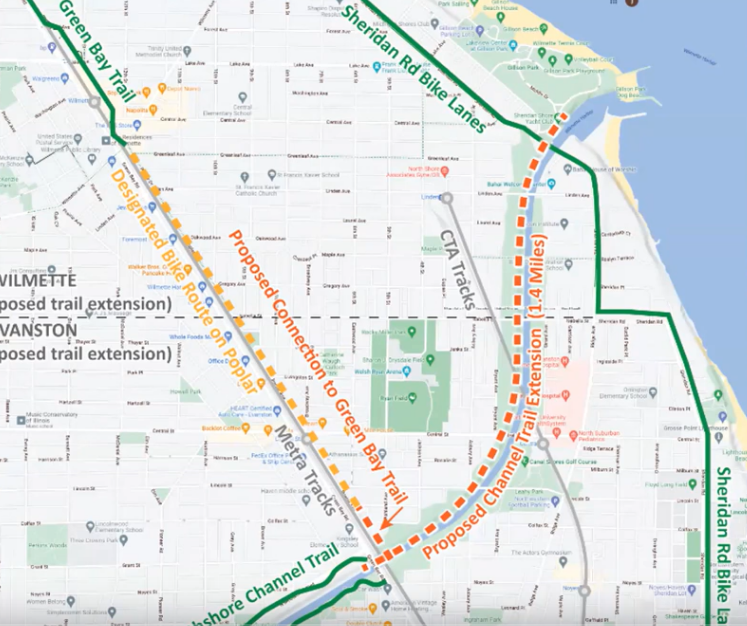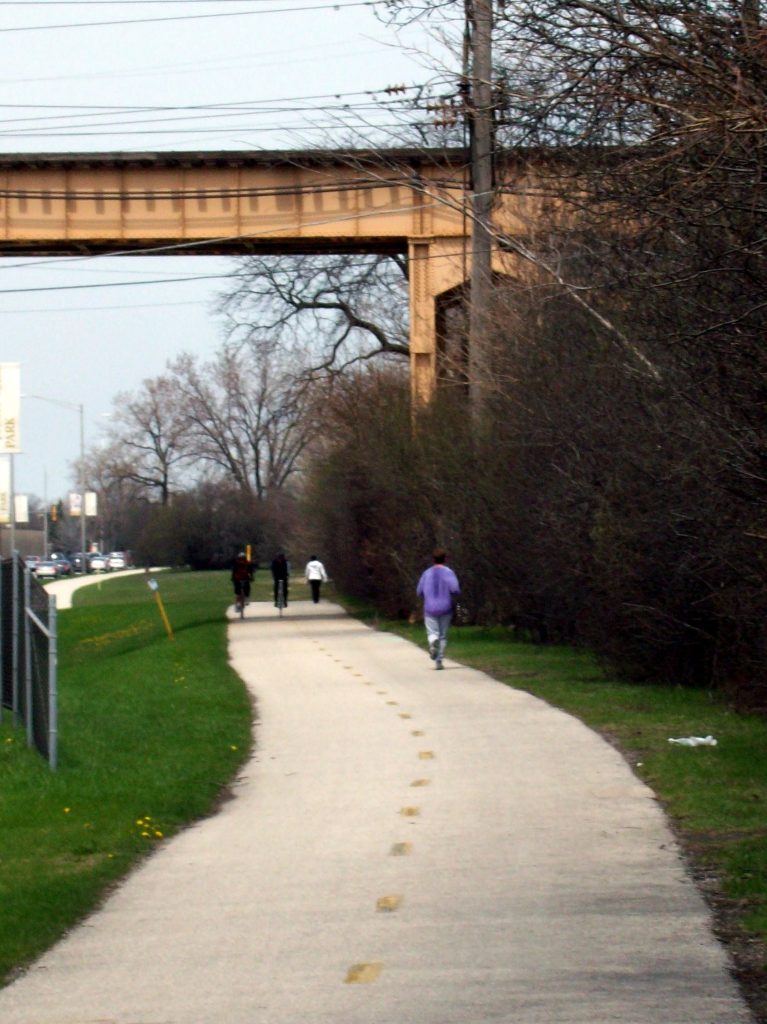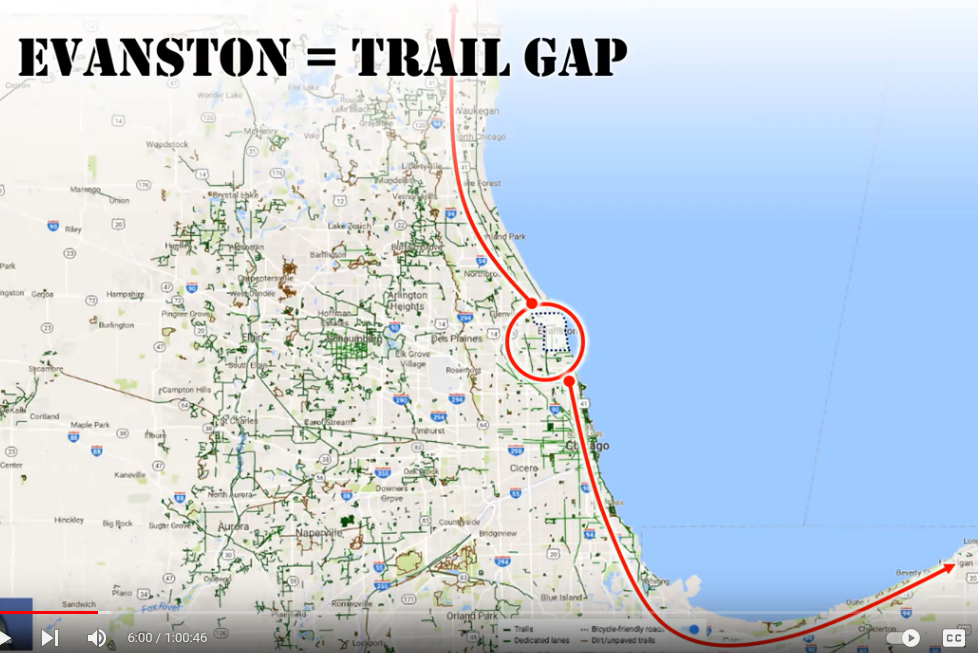Walking and biking trails are dotted throughout Evanston. While many of Evanston’s residents take advantage of those trails, they also find them frustrating.
Many of the trails don’t connect to other local and regional trails, forcing people to walk and bike along dangerous and stressful roadways if they want to move from one trail to another.
But that may change if the Evanston Transit Alliance has its way.
The advocacy group is making progress on connecting the North Shore Channel Trail in Skokie to trails north of Evanston, seeking to bridge some of the gaps in Evanston’s trails and bike lanes and ultimately create a regional trail network in the northern suburbs.
The Evanston Transit Alliance (ETA) is proposing to extend the North Shore Channel Trail about 1.4 miles to the Sheridan Road bike lanes near the lakefront and 1.5 miles to the Green Bay Trail, which stretches 9 miles north from Wilmette to Highland Park.
WHY EXTEND THE TRAIL
The trail extensions will connect communities in the northern suburbs to Evanston and each other, encourage more foot and bike traffic, and spur economic development in those areas, according to John Fervoy, a 25-year Evanston resident and member of the ETA, the advocacy group spearheading the project.
Fervoy said the trail extension will allow more people from northern suburbs to enjoy the 312 RiverRun Bridge, the new Lincoln Avenue Bridge on the North Channel Trail, and plenty of other amenities.
On the northern end of the extension, there’s Northwestern University, Sheridan Road bike lanes, the Green Bay Trail, and Evanston Hospital, among many other destinations and attractions.
Getting both trails built will not be easy. Infrastructure projects of this magnitude often take years to complete.
They require a steady commitment to advocacy and maintaining momentum to keep the projects moving while navigating a complicated, bureaucratic process.
Even though ETA doesn’t have formal public policy, transportation planning and urban planning experience, it says it is up for the challenge.

GATHERING POLITICAL AND COMMUNITY SUPPORT
The ETA was formed in 2012 by a group of Evanston residents to bring attention to the lack of connectivity in Evanston’s trails and bike lanes. It initially hosted group rides and events and published articles in local publications to highlight the problem.
But the group really started to gain traction when it made presentations to elected officials, community leaders, and other stakeholders about how the North Shore Channel Trail extension could solve the problem and create a regional trail system.
The project shifted into high gear in January 2022 when Evanston City Council member Bobby Burns of the historically Black 5th Ward said he would support the trail extension, hoping to encourage more walking and biking among the residents in his ward as well as bring economic activity to the area.
“[After ETA’s presentation,] Bobby Burns said, ‘All right, what’s the next step?’ And that’s something that no one’s ever asked us before. We’re good at talking and doing our activities, but actually making something happen was new for us. So, it was kind of a challenge and an opportunity,” Fervoy said. “Bobby Burns’ interest gave us credibility and was able to attract other politicians and stakeholders in the area.”
In March 2022, ETA started hosting monthly pizza meetings for residents, elected officials and other stakeholders to discuss how to move the project forward.
With guidance from a local urban planner, ETA decided to pursue a feasibility study for the North Shore Channel Trail extension. But first they needed to garner support for such a costly endeavor.
Over the course of the year, ETA continued to host its monthly meetings and make presentations to community leaders, elected officials and other stakeholders.
As a result, the group gathered more than 20 letters of support from stakeholders and institutions in February 2023.
Those concerted efforts continued to pay off.

FEASIBILITY MUST BE ESTABLISHED
In July 2023, with those letters of support in hand, the Wilmette Park District in partnership with the Village of Wilmette and the City of Evanston received a $40,000 grant for the North Shore Channel Trail project from the Invest in Cook grant program from Cook County, which awards funding to improve transit, pedestrian and bicycle paths, and road and freight transportation across Cook County.
The Wilmette Park District will use the funds to conduct a feasibility study for the North Shore Channel Trail extension, focusing on trail locations, costs, and implementation strategy.
The Wilmette Park District entered into an intergovernmental agreement with the Village of Wilmette, City of Evanston, and Cook County, which cements their commitment to matching funds for the feasibility study.
This year, ETA and the Wilmette Park District will execute the feasibility study.
Next steps include issuing requests for proposals to engineering firms.
After a selection committee chooses the engineering firm, a steering committee, which will include ETA, will monitor the work of the engineering firm and progress of the feasibility study.
The feasibility study is expected to be complete by December.
Once the feasibility study determines that the North Shore Channel Trail extension is viable, the Wilmette Park District and ETA will conduct engineering studies before commencing with the engineering phase.
If all goes well, ETA expects the North Shore Channel Trail to be complete by 2030.
“By the end of the decade, hopefully we’re riding on this one-and-a-half mile extension. And, hopefully, we can mend our broken trail network here in Evanston,” Fervoy said. “Instead of Evanston being where the trails end, maybe with more work, we can be the place where bike trails connect.”
During a recent webinar hosted by Active Transportation Alliance, advocates for several north suburban trails shared how communication, collaboration, resourcefulness, and tenacity have been key to successfully advocating for the creation, expansion and maintenance of these trails. This blog post was drawn from the webinar.
___________________________
With support from people like you, Active Transportation Alliance works to make our transportation options safer, more sustainable, and more equitable. You can be part of the movement by joining Active Transportation Alliance, renewing your membership, or donating today.

